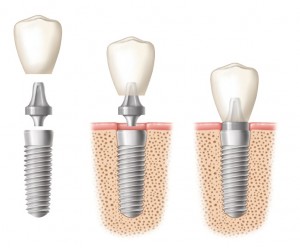 Your teeth, like your fingerprints, are unique – no one else’s are the same as yours. Many options exist to replace missing teeth but only one – dental implants – can provide the feel, function and appearance of natural teeth. While many professionals place dental implants, there’s a difference between “dentists who do implants” and “dental implant experts.” Dr. Lozada is an expert and will provide the best care.
Your teeth, like your fingerprints, are unique – no one else’s are the same as yours. Many options exist to replace missing teeth but only one – dental implants – can provide the feel, function and appearance of natural teeth. While many professionals place dental implants, there’s a difference between “dentists who do implants” and “dental implant experts.” Dr. Lozada is an expert and will provide the best care.
Dental implants are often the best treatment for missing teeth. When a damaged or decayed tooth is removed, both the visible part of the tooth, called the crown, and the root are lost.
A dental implant is placed in the jawbone so that it can fuse with your natural bone and become a strong and sturdy foundation for replacement teeth. Implants can be used to replace an individual tooth or for an implant-supported bridge or denture containing multiple teeth.
Dental implants are the closest you can get to healthy, natural teeth. They will allow you to confidently eat, smile, laugh, talk, play and enjoy all of your regular activities of everyday life without thinking about your teeth.
Teeth restored with dental implants look, feel and function just like natural teeth. You brush, floss and visit your dentist for regular check-ups and cleanings, same as you would to care for a natural tooth.
After meeting with a dental implant dentist like Dr. Igor Lozada to develop your treatment plan, the placement of a dental implant usually involves several steps:
- The dental implant, usually a cylindrical and/or tapered post made of titanium, is placed surgically into the jawbone.
- As you heal, your implant will osseointegrate, or fuse with, your natural jawbone, with the two growing together to form a strong and long-lasting foundation for your replacement teeth.This healing process can take weeks to months while you proceed with your everyday life in between appointments.
- Once the implant bonds with the jawbone, a small connector – called an abutment – is placed on top of the dental implant to connect the implant to the replacement tooth or teeth.
- An individual tooth, an implant-supported bridge or dentures containing multiple teeth are then attached to the abutment.
